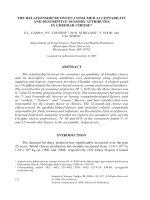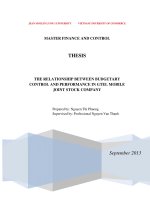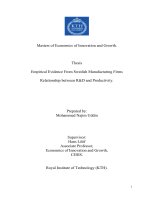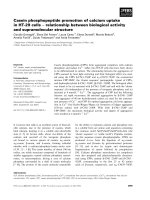Association relationship between personal variables and awareness about weather information sources by farmers of Ranchi district of Jharkhand
Bạn đang xem bản rút gọn của tài liệu. Xem và tải ngay bản đầy đủ của tài liệu tại đây (279.68 KB, 5 trang )
Int.J.Curr.Microbiol.App.Sci (2019) 8(1): 373-377
International Journal of Current Microbiology and Applied Sciences
ISSN: 2319-7706 Volume 8 Number 01 (2019)
Journal homepage:
Original Research Article
/>
Association Relationship between Personal Variables and Awareness about
Weather Information Sources by Farmers of Ranchi District of Jharkhand
Abhilasha Deepa Minz*
Assistant Professor cum Junior Scientist, Department of Agricultural Extension and
Communication, BAU, Ranchi, Jharkhand-834006, India
*Corresponding author
ABSTRACT
Keywords
Awareness,
Weather,
Information,
Effectiveness,
Credibility
Article Info
Accepted:
04 December 2018
Available Online:
10 January 2019
The present research work was conducted in eight selected villages of Ranchi
district of Jharkhand. It was found during investigation that awareness level of
farmers about weather information sources was more in case of traditional sources
and comparatively much less in case of social media. It was also found during the
study that possession of weather information yielding electronic gadgets, access to
internet, need of weather information, effectiveness of weather information,
credibility of weather information sources, contact with extension agencies, mass
media exposure, social participation, innovativeness, cosmopoliteness, family size,
education and annual income were positively correlated while age was negatively
correlated.
Introduction
The sources of weather and climate-related
risks in agriculture are numerous and diverse:
limited
water
resources,
drought,
desertification, land degradation, erosion, hail,
flooding, early frosts and many more.
Effective weather and climate information and
advisory services can inform the decisionmaking of farmers and improve their
management of related agricultural risks. Such
services can help develop sustainable and
economically viable agricultural systems,
improve production and quality, reduce losses
and risks, decrease costs, increase efficiency
in the use of water, labour and energy,
conserve natural resources, and decrease
pollution by agricultural chemicals or other
agents that contribute to the degradation of the
environment (Rathore and Chattopadhyay,
2016). Thus it can be said that weather
information sources play a vital role in
agricultural system and farmers being at the
core of the system must be aware about such
sources. Awareness about weather information
sources is a major challenge and this situation
has been further aggravated by climate
change. The application of meteorology in
373
Int.J.Curr.Microbiol.App.Sci (2019) 8(1): 373-377
agriculture is essential, since every facet of
agricultural activity depends on the weather.
Plant and crop selection are functions of the
climate and of normal changes of the weather.
block was randomly chosen. 15 farmers from
each village were randomly selected for
interview. Thus a sample of 120 respondents
was taken.
Timing of cultural operations, such as
cultivation, application of pesticides and
fertilizers, irrigation and harvesting, is
strongly affected by the weather (Mannava et
al., 2007). A research by Ugwoke et al.,
(2012) claimed that although farmers are
aware of climate change, they do not seem to
know the cause(s). Their knowledge of
climate change is mainly based on personal
experience over time and information from
social organizations. Elements of climate
which they perceived to have changed
significantly include rainfall pattern, sunlight
and temperature. They seem to have perceived
climate change to a fairly large extent.
Perceived adverse effects of climate change
include increased rainfall intensity, flooding,
erosion, excessive heat and poor crop.
Results and Discussion
Materials and Methods
The present study was carried out based on
primary data about socio-personal, socioeconomic and communicational attributes of
respondents which were collected through
personal interview with the help of structured
pre-tested interview schedule. All the weather
information sources available to the farmers in
the study area were enlisted and farmers’
awareness about them was noted.
Awareness about weather information sources
was measured in a three continuum scale i.e.,
completely aware (2), partially aware (1) and
unaware (0). The score then obtained was
summed up and accordingly extent of
awareness and gap in awareness was
measured. In Jharkhand, Ranchi district was
purposively selected. Two blocks namely
Kanke block and Angara block were randomly
selected out of which four villages from each
Awareness
about
information sources
different
weather
Table 1 illustrates the awareness level of
farmers about different weather information
sources. It can be seen that extent of
awareness about traditional sources being the
source of weather information was highest as
their belief towards predictability of weather
and climate change by these sources was due
to their strong orthodox nature.
Next to traditional sources farmers were aware
about television (91.25%) being a source of
weather information. Newspaper (74.17%)
and mobile (78.33%) were also among sources
about which farmers were highly aware.
Among the sources about which the farmers
were least aware were the social media.
Correlation between personal variables and
awareness to weather information sources
Table 2 shows the correlation between
personal variables and awareness to weather
information sources by the farmers.
From the results it can be said that possession
of weather information yielding electronic
gadgets, access to internet, need of weather
information,
effectiveness
of
weather
information,
credibility
of
weather
information sources, mass media exposure,
cosmopoliteness and education are positively
significant at 1 per cent level of significance.
Innovativeness is positively significant at 5
per cent level of significance while age is
negatively correlated with awareness.
374
Int.J.Curr.Microbiol.App.Sci (2019) 8(1): 373-377
Table.1 Awareness level of farmers about weather information sources
Sl.
No.
1.
2.
3.
4.
Particular
Print media
Newspaper
Magazine
Electronic media
Mobile
Radio
TV
Mobile Agriculture App
Websites/ Portal
Social media
Other social media
Traditional media
Pujari
Pahan
Others (friends/relatives)
Maximum
score
Obtained
score
Extent of
awareness (%)
Gap
(%)
240
240
178
30
74.17
12.50
25.83
87.50
240
240
240
240
240
188
140
219
21
24
78.33
58.33
91.25
8.75
10.00
21.67
41.67
8.75
91.25
90.00
240
240
240
240
51
46
10
12
21.25
19.17
4.17
5.00
78.75
80.83
95.83
95.00
240
240
240
229
238
234
95.42
99.17
97.50
4.58
0.83
2.50
Table.2 Correlation analysis between personal variables and awareness to weather information
sources
Personal Variables
(X1)-Possession of weather information yielding electronic
gadgets
(X2)-Access to internet
(X3)-Need of weather information
(X4)-Effectiveness of weather information
(X5)-Credibility of weather information sources
(X6)-Contact with extension agencies
(X7)-Social participation
(X8)-Mass media exposure
(X9)-Innovativeness
(X10)-Cosmopoliteness
(X11)-Age
(X12)-Family size
(X13)-Education
(X14)-Annual income
375
Correlation Coefficient
0.395**
0.312**
0.700**
0.888**
0.877**
0.116
0.028
0.619**
0.224*
0.317**
-0.020
0.029
0.354**
0.040
Int.J.Curr.Microbiol.App.Sci (2019) 8(1): 373-377
Table.3 Regression coefficient between independent variables and awareness about weather
information sources (Y1)
Variable
(X1)-Possession of weather information yielding electronic
gadgets
(X2)-Access to internet
(X3)-Need of weather information
(X4)-Effectiveness of weather information
(X5)-Credibility of weather information sources
(X6)-Contact with extension agencies
(X7)-Social participation
(X8)-Mass media exposure
(X9)-Innovativeness
(X10)-Cosmopoliteness
(X11)-Age
(X12)-Family size
(X13)-Education
(X14)-Annual income
R2 value:
S.E. of regression:
0.825
1.649
“b” value
-0.852
“t” value
-0.363
-0.273
1.439**
0.115**
0.005
0.210
-0.194
0.184*
-0.072
0.005*
-0.001
0.096
0.185
0.022
-0.709
2.8774
3.760
0.270
1.402
-1.413
2.167
-1.820
2.206
-0.032
1.333
1.360
0.625
*Significant at 5 % level of significance
**Significant
at 1% level of significance
Table.4 Model Summary of regression of independent variables with awareness about weather
information sources
Model No.
Variables included in the models
Multiple R2
M1
X4, X3, X8
0.821
M2
X4, X3
0.808
M3
X4
0.788
need of weather information (1.439) and
effectiveness of weather information (0.115)
were positively significant at 1 per cent level
of significance. Mass media exposure (0.184),
Cosmopoliteness (0.005) was also positively
significant at 5 per cent level of significance
while rest of the variables were nonsignificant.
Regression between personal variables and
awareness about weather information
sources
Table 3 shows the regression coefficient of
personal variables with awareness about
weather information sources of the
respondents and it can be said that all
personal variables taken together explains
84.8 per cent variability (R2 = 0.825) in
awareness about weather information sources.
Through regression analysis, it was found that
Table 4 shows the model summary of
regression of personal variables with
awareness about weather information sources.
376
Int.J.Curr.Microbiol.App.Sci (2019) 8(1): 373-377
Different models were tested for finding their
predicting capacity for variability in
awareness about weather information sources.
Model-1 revealed that effectiveness of
weather information sources, need of weather
information and mass media exposure
together explained 82.1 per cent variability in
awareness.
Effectiveness
of
weather
information and need of weather information
explained 80.8 per cent variability and alone
effectiveness
of
weather
information
explained 78.8 per cent variability in
dependent variable.
weather updates in their agricultural activities
with which their need of weather information
could be improvised. For better mass media
exposure, the farmers must be made aware
about the weather information sources already
present around them and how to better utilize
them. Apart from this there may be other
constraints and variables which affect the
awareness about weather information sources.
Further research must be done keeping those
factors in kind and ways should be developed
to minimize such constraints.
References
In conclusion, from the above research
conducted it was found that the perception of
farmers about effectiveness of weather
information sources, need of weather
information and mass media exposure were
the major variables which explained change
in awareness about weather information
sources. Thus it can be said that by
manipulating these variables desired outcome
could be obtained and gap in awareness could
be minimized. The perception of farmers
about effectiveness of weather information
sources needs to be enhanced by providing
this information in easily interpretable form
and at local level. Furthermore, the farmers
must be made aware about the importance of
Rathore, L. S. and Chattopadhyay, N. 2016.
Weather and climate services for
farmers in India. Int. J. Agriculture and
Food Security, 65(2).
Mannava, V., Sivakumar, K. and Motha, R.
2007. Managing weather and climate
risks in agriculture. Agricultural
Meteorology 60: 525-528.
Ugwoke, F. O., Nnadi, F. N., Anaeto, C. F.,
Aja, O. O. and Nwakwasi, R. N; Crop
Farmers’ Perception of an Adaptation to
Climate Change in Orlu Agricultural
Zone of Imo State, Nigeria. Journal of
Agricultural Extension 2012; 16(2):212223.
How to cite this article:
Abhilasha Deepa Minz. 2019. Association Relationship between Personal Variables and
Awareness about Weather Information Sources by Farmers of Ranchi District of Jharkhand.
Int.J.Curr.Microbiol.App.Sci. 8(01): 373-377. doi: />
377









